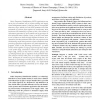Free Online Productivity Tools
i2Speak
i2Symbol
i2OCR
iTex2Img
iWeb2Print
iWeb2Shot
i2Type
iPdf2Split
iPdf2Merge
i2Bopomofo
i2Arabic
i2Style
i2Image
i2PDF
iLatex2Rtf
Sci2ools
102
click to vote
ICDE
2006
IEEE
2006
IEEE
Warehousing and Analyzing Massive RFID Data Sets
Radio Frequency Identification (RFID) applications are set to play an essential role in object tracking and supply chain management systems. In the near future, it is expected that every major retailer will use RFID systems to track the movement of products from suppliers to warehouses, store backrooms and eventually to points of sale. The volume of information generated by such systems can be enormous as each individual item (a pallet, a case, or an SKU) will leave a trail of data as it moves through different locations. As a departure from the traditional data cube, we propose a new warehousing model that preserves object transitions while providing significant compression and path-dependent aggregates, based on the following observations: (1) items usually move together in large groups through early stages in the system (e.g., distribution centers) and only in later stages (e.g., stores) do they move in smaller groups, and (2) although RFID data is registered at the primitive level...
| Added | 01 Nov 2009 |
| Updated | 01 Nov 2009 |
| Type | Conference |
| Year | 2006 |
| Where | ICDE |
| Authors | Hector Gonzalez, Jiawei Han, Xiaolei Li, Diego Klabjan |
Comments (0)

